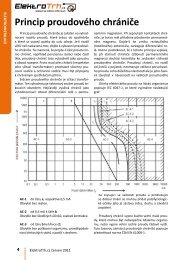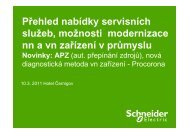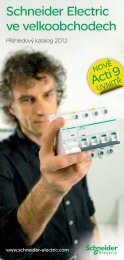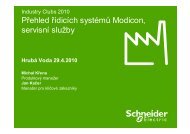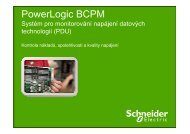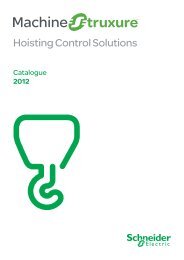2010Annual Report - Schneider Electric CZ, s.r.o.
2010Annual Report - Schneider Electric CZ, s.r.o.
2010Annual Report - Schneider Electric CZ, s.r.o.
Create successful ePaper yourself
Turn your PDF publications into a flip-book with our unique Google optimized e-Paper software.
1. 3 The emergence of new economies<br />
The world’s center of gravity is shifting, as are the opportunities for<br />
growth.<br />
Emerging economies are challenging mature countries for economic<br />
supremacy, for example China, which became the world’s second<br />
biggest economy in 2010.<br />
With globalisation of economies and trade, people have completely<br />
changed the way they do business, think of economic growth and<br />
1. 4 A Group focused on growth<br />
From steel to electricity, and then to energy management: the Group<br />
has gone through many changes since it was founded 175 years<br />
ago in order to position itself in the most important growth markets.<br />
1836 – 1980: From family business to world<br />
leader<br />
1836: Adolphe and Joseph-Eugène <strong>Schneider</strong> acquired steel<br />
foundries in Le Creusot, France. They founded <strong>Schneider</strong> & Cie in<br />
1838. The Company steadily built a presence in heavy mechanical<br />
engineering and transportation equipment, gradually becoming a<br />
huge, highly diversifi ed conglomerate.<br />
1975: Merlin Gerin, a leading French manufacturer of electrical<br />
distribution equipment, joined the Group in 1975, strengthening a<br />
position in electricity that had been established at the end of the<br />
19th century.<br />
1981 – 2001: The Group refocuses on electricity<br />
1988: Acquisition of France’s Telemecanique, a pioneer in remote<br />
control systems for electric motors.<br />
1991: Major acquisition of the US electrical equipment sector leader<br />
Square D (sales of USD1.65 billion).<br />
1997: Sale of building and public works company Spie Batignolles.<br />
The Group’s refocusing on the electricity sector is now complete.<br />
1999: The name <strong>Schneider</strong> <strong>Electric</strong> represents the Group’s new<br />
direction and provides a clear indication of its expertise in the<br />
electricity sector.<br />
• Acquisition of Lexel, Europe’s second largest supplier of<br />
installation systems and control solutions.<br />
2000: Acquisition of Crouzet Automatismes, a French leader in<br />
electronic control, small automation devices and customised<br />
sensors, and Positec, a European leader in motion control.<br />
• Establishment of 60-40 joint venture with Toshiba called<br />
<strong>Schneider</strong> Toshiba Inverters (STI) to develop, manufacture and<br />
market both partners’ industrial speed drives. STI leads the<br />
global industrial speed drive sector.<br />
• Launch of <strong>Schneider</strong> <strong>Electric</strong> Ventures fund with capital of<br />
EUR50 million, to acquire interests in innovative start-ups with<br />
technologies that can enhance the line up.<br />
DESCRIPTION OF THE GROUP, AND ITS STRATEGY, MARKETS AND BUSINESSES<br />
GLOBAL SPECIALIST IN ENERGY MANAGEMENT<br />
collaborate with stakeholders over the last two decades. It is no<br />
longer simply a case of exporting technology; innovation is required<br />
to meet the needs of each market. <strong>Schneider</strong> <strong>Electric</strong>’s presence in<br />
more than 100 countries as well as its new organisation represent<br />
decisive strengths for meeting these new challenges.<br />
2001: Acquisition of Legrand, a leader in installation systems and<br />
control solutions. The European Commission then vetoed the<br />
merger, obliging <strong>Schneider</strong> <strong>Electric</strong> to sell its stake in Legrand, even<br />
though the Court of First Instance of the European Communities<br />
overruled the Commission’s decision in October 2002.<br />
2002-2009: Strategic transformation<br />
Around the beginning of the new millennium, <strong>Schneider</strong> <strong>Electric</strong><br />
completely rethought its growth strategy, setting itself three goals:<br />
• diversifying its exposure to end markets;<br />
• enhancing its portfolio of traditional activities (electricity<br />
distribution, automation and industrial control);<br />
• anticipating the future energy requirements of fi rms and homes.<br />
New dimension<br />
The Group doubled in size between 2002 and 2008, through<br />
organic growth and by making a number of acquisitions. Revenue<br />
jumped from EUR9 billion in 2002 to EUR18.3 billion in 2008,<br />
refl ecting average annual growth of 12%. Its headcount increased<br />
from 70,000 to 114,000 over the same period. Thanks to a loosely<br />
integrated business model, the Group can act quickly to keep pace<br />
with economic and environment-related changes.<br />
2003: Following several acquisitions, notably of TAC, <strong>Schneider</strong><br />
<strong>Electric</strong> became a major player in building automation.<br />
2007: The Group became global leader in critical power and video<br />
security systems, with the acquisition of APC and Pelco respectively.<br />
2009: The acquisitions of energy effi ciency leader Conzerv in India<br />
and UPS manufacturer Microsol Tecnologia in Brazil increased the<br />
Group’s exposure to new economies, as well as to the growing<br />
energy effi ciency and critical power sectors.<br />
Change management<br />
2001-2008: Launch of change management program NEW2004,<br />
followed by NEW2 in 2005, with the aim of formalising consistent<br />
and coordinated objectives for all employees.<br />
2010 REGISTRATION DOCUMENT SCHNEIDER ELECTRIC 17<br />
1




